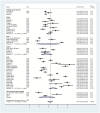Prognostic value of sarcopenia in aortic valve replacement: a systematic review and meta-analysis
- PMID: 40799522
- PMCID: PMC12339327
- DOI: 10.3389/fnut.2025.1529270
Prognostic value of sarcopenia in aortic valve replacement: a systematic review and meta-analysis
Abstract
Objective: This study aimed to quantify the prevalence of sarcopenia in patients undergoing surgical aortic valve replacement (SAVR) or transcatheter aortic valve replacement (TAVR), and to assess its association with mortality risk.
Methods: Relevant studies were identified through searches of the PubMed, Cochrane Library, Excerpta Medica Database (Embase), Web of Science, and China National Knowledge Infrastructure (CNKI) from inception through July 1, 2025. The prevalence of sarcopenia and its 95% confidence interval (CI) were calculated, with heterogeneity evaluated using the I 2 statistic. The link between sarcopenia and mortality following SAVR/TAVR was quantified by hazard ratio (HR) or odds ratio (OR) with 95% CI. Statistical analyses were conducted using Stata 11.0.
Results: Thirty-eight studies were included, with 6 focusing on patients undergoing SAVR and 32 on those undergoing TAVR. Sarcopenia was defined by skeletal mass index in 16 studies, while only 2 studies adopted criteria combining reduced muscle mass with low muscle strength and/or reduced physical performance. Sarcopenia's prevalence among SAVR patients was 31.3% (95% CI 25.3-37.6%). In this cohort, sarcopenia was linked to a significantly higher risk of long-term (≥1 year) mortality (HR = 3.10, 95% CI 2.00-4.79, p < 0.001). In contrast, the prevalence of sarcopenia in TAVR patients was 43.7% (95% CI 38.6-48.9%), with sarcopenia also correlating with increased long-term (>2 year) mortality (HR = 1.25, 95% CI 1.09-1.44, p = 0.001). These associations remained consistent across various follow-up durations, definitions of sarcopenia, and ethnic groups.
Conclusion: Despite the variation in diagnostic criteria, sarcopenia is significantly prevalent in both SAVR and TAVR populations, with a clear association with elevated long-term mortality following these procedures.
Systematic review registration: https://www.crd.york.ac.uk/PROSPERO/, identifier CRD42024606633.
Keywords: SAVR; TAVR; meta-analysis; prevalence; sarcopenia; systematic review.
Copyright © 2025 He.
Conflict of interest statement
The author declares that the research was conducted in the absence of any commercial or financial relationships that could be construed as a potential conflict of interest.
Figures





Similar articles
-
Evaluating long-term outcomes and the impact of small aortic annulus on valve replacement-a novel systematic review and meta-analysis comparing surgery vs. transcatheter interventions.Front Cardiovasc Med. 2025 Jun 26;12:1555853. doi: 10.3389/fcvm.2025.1555853. eCollection 2025. Front Cardiovasc Med. 2025. PMID: 40642752 Free PMC article.
-
Transcatheter Versus Surgical Aortic Valve Replacement in Patients with Polyvascular Disease.Cardiol Ther. 2025 Sep;14(3):423-437. doi: 10.1007/s40119-025-00415-7. Epub 2025 May 18. Cardiol Ther. 2025. PMID: 40382742 Free PMC article.
-
Diagnosis, prevalence, and mortality of sarcopenia in dialysis patients: a systematic review and meta-analysis.J Cachexia Sarcopenia Muscle. 2022 Feb;13(1):145-158. doi: 10.1002/jcsm.12890. Epub 2022 Jan 5. J Cachexia Sarcopenia Muscle. 2022. PMID: 34989172 Free PMC article.
-
Transcatheter Aortic Valve Replacement is Associated with Comparable Clinical Outcomes to Open Aortic Valve Surgery but with a Reduced Length of In-Patient Hospital Stay: A Systematic Review and Meta-Analysis of Randomised Trials.Heart Lung Circ. 2017 Mar;26(3):285-295. doi: 10.1016/j.hlc.2016.07.011. Epub 2016 Aug 29. Heart Lung Circ. 2017. PMID: 27646577
-
Prescription of Controlled Substances: Benefits and Risks.2025 Jul 6. In: StatPearls [Internet]. Treasure Island (FL): StatPearls Publishing; 2025 Jan–. 2025 Jul 6. In: StatPearls [Internet]. Treasure Island (FL): StatPearls Publishing; 2025 Jan–. PMID: 30726003 Free Books & Documents.
References
-
- Thongprayoon C, Cheungpasitporn W, Gillaspie EA, Greason KL, Kashani KB. The risk of acute kidney injury following transapical versus transfemoral transcatheter aortic valve replacement: a systematic review and meta-analysis. Clin Kidney J. (2016) 9:560–6. doi: 10.1093/ckj/sfw055, PMID: - DOI - PMC - PubMed
-
- Rumsfeld JS, MaWhinney S, McCarthy M, Jr, Shroyer AL, VillaNueva CB, O'Brien M, et al. Health-related quality of life as a predictor of mortality following coronary artery bypass graft surgery. Participants of the Department of Veterans Affairs Cooperative Study Group on processes, structures, and outcomes of Care in Cardiac Surgery. JAMA. (1999) 281:1298–303. doi: 10.1001/jama.281.14.1298 - DOI - PubMed
Publication types
LinkOut - more resources
Full Text Sources

